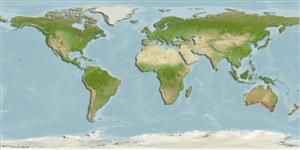Environment: milieu / climate zone / depth range / distribution range
Ökologie
seewasser demersal. Temperate
Eastern Indian Ocean: southern Australia, from Western Australia to Tasmania.
Size / Gewicht / Alter
Maturity: Lm ? range ? - ? cm
Max length : 21.0 cm TL Männchen/unbestimmt; (Ref. 557)
Inhabits rock reef. Benthic (Ref. 75154). In shallow coastal waters, occasionally taken by anglers (Ref. 557). Neither anterolateral glandural groove nor venom gland is present (Ref. 57406).
Life cycle and mating behavior
Geschlechtsreife | Fortpflanzung | Ablaichen | Eier | Fecundity | Larven
Wheeler, A., 1977. Das grosse Buch der Fische. Eugen Ulmer GmbH & Co. Stuttgart. 356 p. (Ref. 557)
IUCN Rote Liste Status (Ref. 130435: Version 2024-1)
Nutzung durch Menschen
Tools
Zusatzinformationen
Download XML
Internet Quellen
Estimates based on models
Preferred temperature (Ref.
123201): 15 - 20.2, mean 17.1 °C (based on 108 cells).
Phylogenetic diversity index (Ref.
82804): PD
50 = 1.1250 [Uniqueness, from 0.5 = low to 2.0 = high].
Bayesian length-weight: a=0.00389 (0.00180 - 0.00842), b=3.12 (2.94 - 3.30), in cm total length, based on all LWR estimates for this body shape (Ref.
93245).
Trophic level (Ref.
69278): 3.6 ±0.4 se; based on size and trophs of closest relatives
Fishing Vulnerability (Ref.
59153): Low vulnerability (11 of 100).
Nutrients (Ref.
124155): Calcium = 70.2 [33.7, 144.8] mg/100g; Iron = 0.407 [0.202, 0.782] mg/100g; Protein = 17 [16, 18] %; Omega3 = 0.613 [0.255, 1.714] g/100g; Selenium = 12.2 [5.3, 29.3] μg/100g; VitaminA = 24.8 [6.9, 82.5] μg/100g; Zinc = 0.722 [0.498, 1.056] mg/100g (wet weight);
